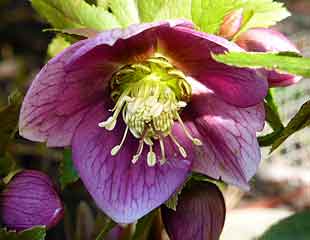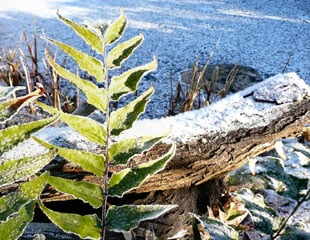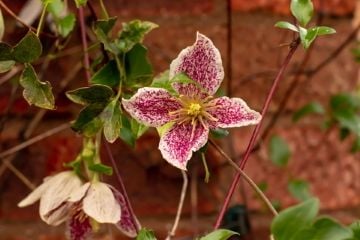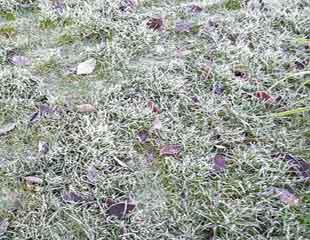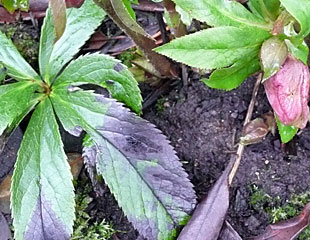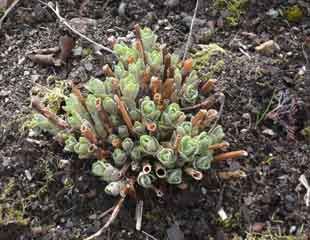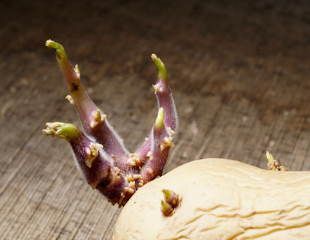What to do in the Garden in January
Enjoy the peace and calm of January. There is not a lot to do in the garden. Come February, things begin to get busy. February is a pruning month. Just a few jobs for the milder days of January.
It used to be the case that late autumn and winter were "tidy up" times in the garden. Traditionally, gardeners cut back perennials, swept away leaves, and tidied borders. The trend now is more wildlife friendly, relaxed gardening.
We no longer consider leaves in the border the hazard they once were, harboring all sorts of pests and diseases. Personally, I would not bother moving any leaves around unless they are on the lawn or in a pond. On the lawn, the leaves can cause die back to the grass underneath. In the pond, leaves add to the nutrients and that, in turn, can make a pond more green in the spring. Green ponds are tricky but you can resolve a green pond, tips and advice here.
There are some lovely shrubs and plants emerging in January and here are some planting ideas
Lawn Care in cold weather
It's true that walking on the frost frozen grass does damage the lawn. When frozen, the blades of grass become brittle, and do not yield to pressure. When trodden on in frosty conditions, the blades of grass will snap and break.
The image shows where people walked on the grass, and it will not recover easily. Damaged areas of the grass show brown marks that will look unsightly in the spring. In addition, the damage will make that patch more susceptible to disease.
Given how hard it is to create a decent lawn, it's worth resisting walking on it during the very cold weather.
Taking Care of the Birds
January is a quiet month in the garden. It is cold for us and for the birds, so it's a good time to look after wildlife. Besides putting out food, birdbaths can freeze, which deprives the birds of a much-needed source of water. Shrubs with berries are important for the birds, but by this time of year, often the birds have eaten all the berries. This means a regular top up of the bird feeders is essential to the survival of many birds through the winter months.
You can entice more birds into your garden if you make it a haven for them. Shelter, food and water is what birds are looking for. Check out shrubs and plants attractive to birds.
What to do on mild days
There are always some mild days in January. Christmas and New Year 2025 were mild and, at times, wild. Plant evergreen shrubs when the ground is not frozen and temperatures are mild. As I am forever saying on this website, newly planted shrubs need lots, and lots, and lots of water, which makes winter and autumn prime planting time. I've listed some January gardening jobs below that you can tackle on mild days, such as pruning wisteria and roses.
Surprisingly, you can also look out for some moths and butterflies which will emerge on mild January days. Credit this image to a Facebook post by Butterfly Conservation, a charity supporting butterflies and moths and a source of reliable information.This link takes you to the butterfly conservation page, which explains why you may be able to spot moths and butterflies in January. Essentially some moths and butterflies retain their adult form over winter, as compared to lava or pupa and will venter out on warmer days. A treat worth looking for.
January Gardening Jobs
Many plants have died back, which makes it easier to see the perennial weeds. Winter is a good time to weed, there is less risk of standing on other plants or of damaging fresh shoots.
A mild spell in January is a suitable time to cut back Rosa Rugosa to take out any weak spindly stems.
Many roses will have shed their leaves. If you had black spot during the previous summer, it is worth sweeping up and collecting any fallen rose leaves and disposing of them to reduce the spread of disease.
Prune climbing roses any time during Jan/feb in a mild spell. Remove old branches from the base to encourage new shoots. Prune out any crossing branches, dead or diseased and shorten side shoots by 2/3rds.
Wisteria can be prune at any time during January and February. Tips on how to do a winter prune and video.
Before the worst of the weather arrives, protect tender plants, bringing them under cover. Plants such as tender evergreen Agapanthus, Zantedeschia (Calla lily) and Canna need either a good mulch, or moving into a greenhouse. If you live in a mild part of the country, it may be enough to wrap the containers and/or mulch. The problem is our winters are less predictable and the beast from the east struck nationwide in 2018 and such cold winds can be damaging.
If prolonged cold temperatures are forecast, it is worth draining water butts, take a look winter gardening tips to see what can (and did) happen in a long cold spell.
Look after winter bedding
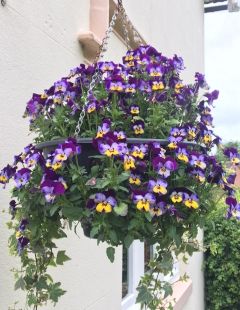
Winter bedding needs dead heading just the same as summer bedding to prolong flowering. It can be more important with winter bedding, which can struggle against the weather to flower.Dead head viola, Pansey cyclamen and they will reward with more flowers.
In some areas, particularly the northern part of of the Uk, where it is wetter and light levels lower, it can be more difficult to get winter bedding to flourish. To overcome this, try growing winter bedding in a hanging basket. This lifts the plant higher in terms of light and out of the wet, chilly soil.
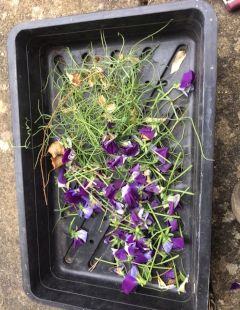
If you have black spot on Hellebores, as shown above, it's best to remove the diseased leaves.
It may seem dramatic, but you really can remove many, if not most, of the leaves from Hellebores without causing the plants any difficulties at all. Some professional growers routinely remove the leaves to better display the flowers. Check out the link below to see how to deal with Hellebore black spot, how many leaves to remove and some "before and after" images.
Winter weeding
If you are a tidy garden person, cut back the old growth on perennials. Equally perennials can be left unpruned until the spring. It's a matter of gardening preference. I tend to leave perennials uncut until the spring as the foilage harbours many insects.
What is interesting is the garden doesn't sleep in winter. When you cut back a Sedum, the new shoots are revealed, already growing. Sedums are a great garden plant about growing Sedums.
There are many shrubs and plants which are at their best in winter if you would like to create a winter display. Most are tough and easy to grow, with a long flowering season. Ideas and gallery of Plants and Shrubs in flower in January.
January in the veg plot
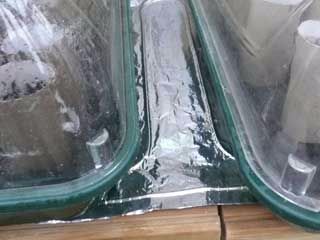
Sowing Early Seeds
It is possible to sow some early seeds in January. Often gardeners are bursting with enthusiasm to start sowing. Tempting it is, but there can be problems.
To sow anything in January, you need warmth and light. This means using heated propagator mats, additional grow lights or growing indoors on windowsills.
Bear in mind everything you germinate early in the year, those young seedlings to grow on in the warm somewhere. The young plants cannot go outside, potentially for several months, which means you need plenty of space to grow the seedlings under glass to protect them. Everything you sow now/or buy from the garden centre as a plug plant will have to be grown under glass until frost is over. If space is short, it's best to wait until later in the year.
A heated propagator mat is good if you want to get seedlings going early. The average conservatory/greenhouse is too cold to germinate seeds, and this heated aluminium mat (illustrated left the propagator trays stand on it,) is ideal for starting off germination. More Advice top 10 tips on how to germinate from seed and a short video looking at growing veg from seed.
One of the main problems growing seedlings at this time of year is not just the cold, but also low light levels. This can cause seedlings to be spindly and leggy. Often, light is from one side only, and the seedlings become leggy, growing towards the single source of light. Check out what to do about leggy seedlings.
Two very different types of seeds are often grown in January.
Chilli seeds because they need a long growing season in order to fruit well. Chilli seeds need both heat and light to germinate and here is more information about growing Chillies from seed. These will need to be grown in doors/in a heated greenhosue.
Sweet Peas can be germinated on a heated mat and once established are fine in an unheated greenhouse, lean to or under glass. They are hardy down to - 5. Sowing early gives a head start for earlier planting out and flowers.
January is time to buy seed potatoes, and later in the month start chitting the first earlies. This is particularly the case if you garden in a sheltered or milder area of the country. If your garden is cold, wet or exposed, you may wish to move your gardening calendar forward a few weeks. The best way to start chitting potatoes is to place the potatoes on paper or in egg boxes in a cool place and leave for the shoots to appear. Keep the potatoes in a cool place out of direct sunlight, too much warmth will make leggy shoots.
Chitting takes about 6 weeks, by which time the shoots should be around 2.5 cms long. Take care when handling and planting not to damage the shoots.
Detailed advice about growing potatoes and information about blight resistant potatoes.
Dealing Botrytis Grey Mold
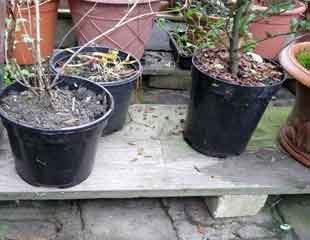
If you are over wintering plants or starting off new seedlings in the greenhouse, mildew and mould can be a problem. To reduce the risk of Botrytis, increase air flow. On mild days, ventilate the greenhouse by opening all the doors and vents. Also, raise pots off the ground to aid air flow and to reduce frost damage, as illustrated.
At first signs of disease move the plant out of the greenhouse to prevent spread.
Botrytis shows on the plant as soft grey mould and when you touch the plant, the mould showers off and the plant crumbles; move it away from other plants to reduce infection.
For plants being overwintered, it is important to reduce watering to a minimum, keeping the plant quite dry over the winter.

